Have you ever seen a striped tail disappearing into the bushes and wondered what animal it could be? Depending on where you are in the world, it could be a variety of creatures! From birds to lizards to mammals, animals on almost every continent have distinctive bars on their tails. Here are 23 animals with striped tails.
1. Raccoon
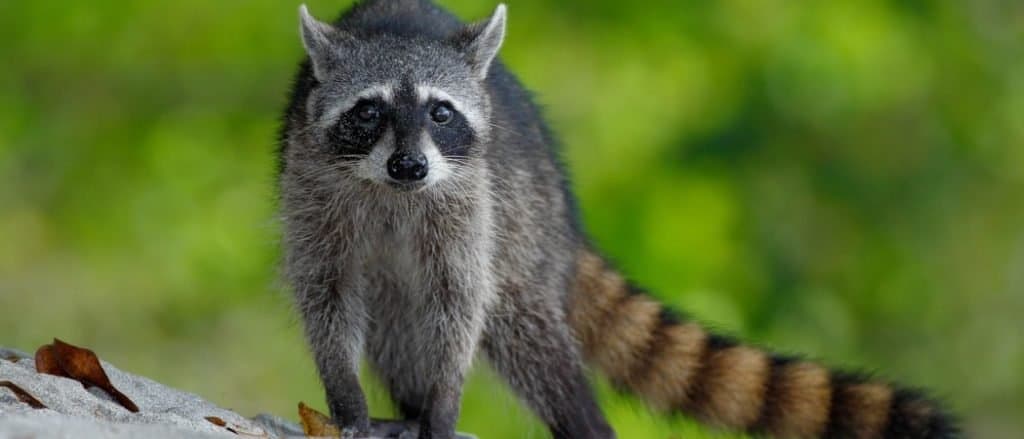
The nocturnal raccoon has excellent night vision and great senses of hearing and touch.
©Ondrej Prosicky/Shutterstock.com
Native to North and Central America, the raccoon is well known for its black-and-brown striped tail, puffy fur, and distinctive black face mask. The raccoon’s tail averages 8-16 inches long — about 1/3 as long as its body length. While most raccoons weigh 12-36 pounds, the biggest raccoon on record weighed a massive 75 pounds!
2. Striped Skunk
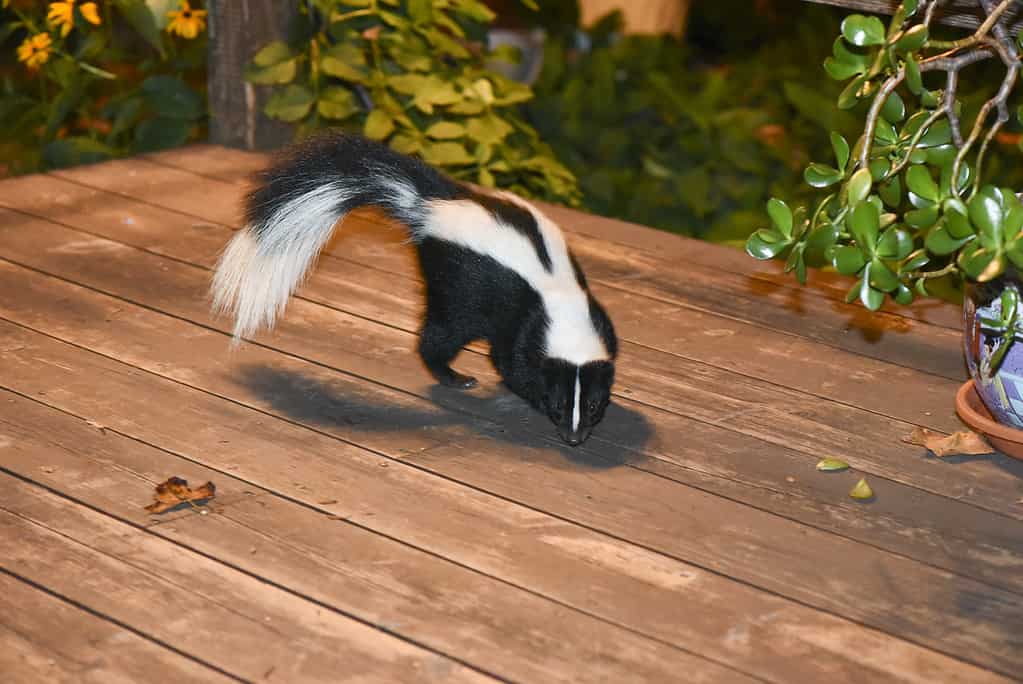
Most predators avoid skunks, but great horned owls often catch and eat them.
©Photon-Photos/iStock via Getty Images
Many people avoid the striped skunk because of its odor, but those who steer clear don’t see its lovely striped tail! Found across the United States and into southern Canada and northern Mexico, the striped skunk is primarily black with two distinct white stripes running down its body from its head through its tail. These stripes warn predators to back off — when the skunk is threatened, it can shoot a precision stream of foul-smelling musky oil up to 10 feet!
3. Ring-Tailed Lemur

Unlike other species in multiple regions, ring-tailed lemurs live only in Madagascar.
©Marcin Mierzejewski/Shutterstock.com
One of the first animals with striped tails that comes to mind is the ring-tailed lemur. The lemur’s impressive striped tail is longer than its body and can measure over 2 feet long. Native to southwestern Madagascar, these delightful lemurs use their tails for balance and communication with other lemurs. They will also wave their tails during play fighting, particularly during breeding season.
4. Red Panda
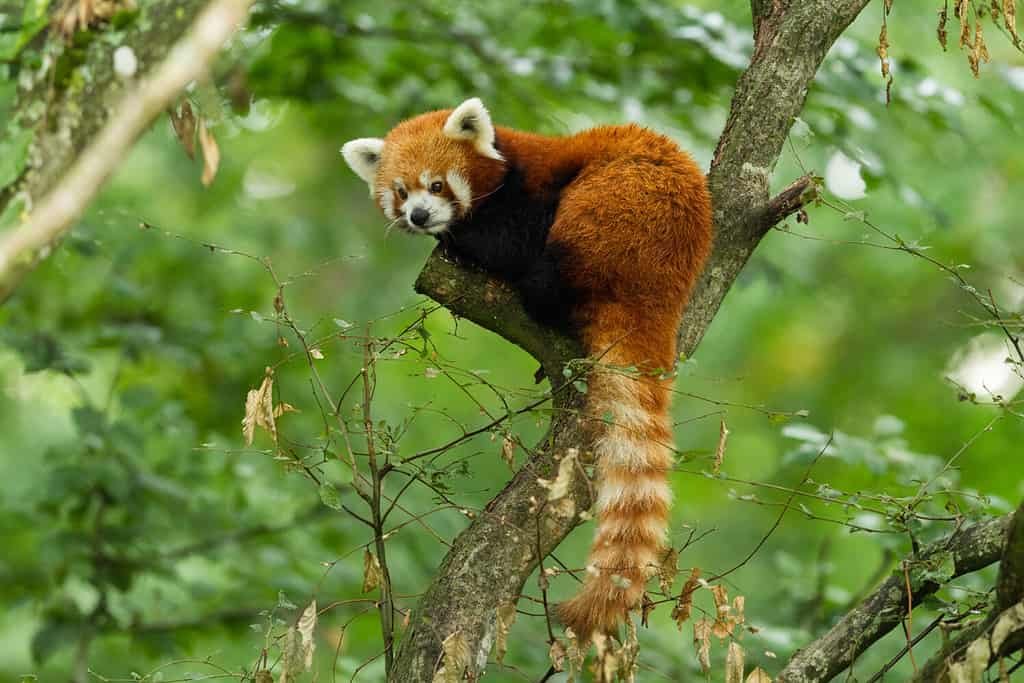
Bamboo makes up 98% of the red panda’s diet.
©AB Photographie/Shutterstock.com
The red panda is a short, fluffy animal with a white nose and ears, a red body, black legs and underbellies, and a red-striped tail. Despite their name, they are not related to pandas and are not a bear family member. Red pandas fall into their classification in the Ailuridae family and are more closely related to the mustelids, such as skunks, raccoons, and weasels. They can be found in southwest China and the eastern Himalayas.
5. House Gecko
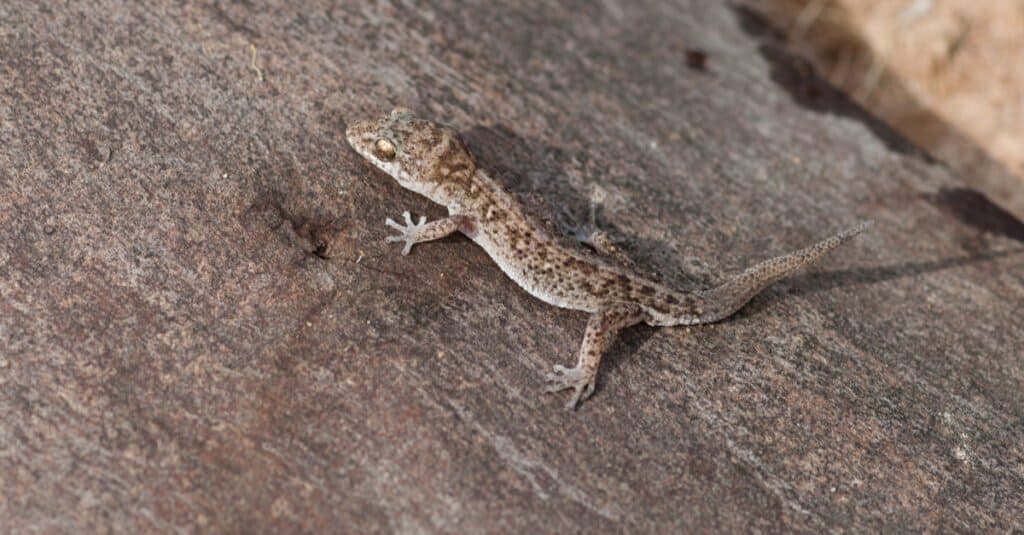
The gecko’s clingy toes make it an excellent climber.
©DOME PRATUMTONG/Shutterstock.com
The common house gecko gets its name because it regularly infiltrates houses. While it is beneficial to have outdoors (where they eat insects and pests), they are adept at sneaking inside and crawling up walls. Native to south and southeast Asia, these small geckos are nocturnal and usually hide during the day.
6. Barred Owl

Barred owl
s can live over 20 years in captivity.
©Lynn_Bystrom/Shutterstock.com
The barred owl’s name comes from the bars of brown feathers across its chest. These brown and white stripes continue through the owl’s wings and tails. Large black eyes take up most of its face. These owls make many different vocalizations but are well known for their call that resembles someone saying, “Who cooks for you? Who cooks for you?”
7. Zebra
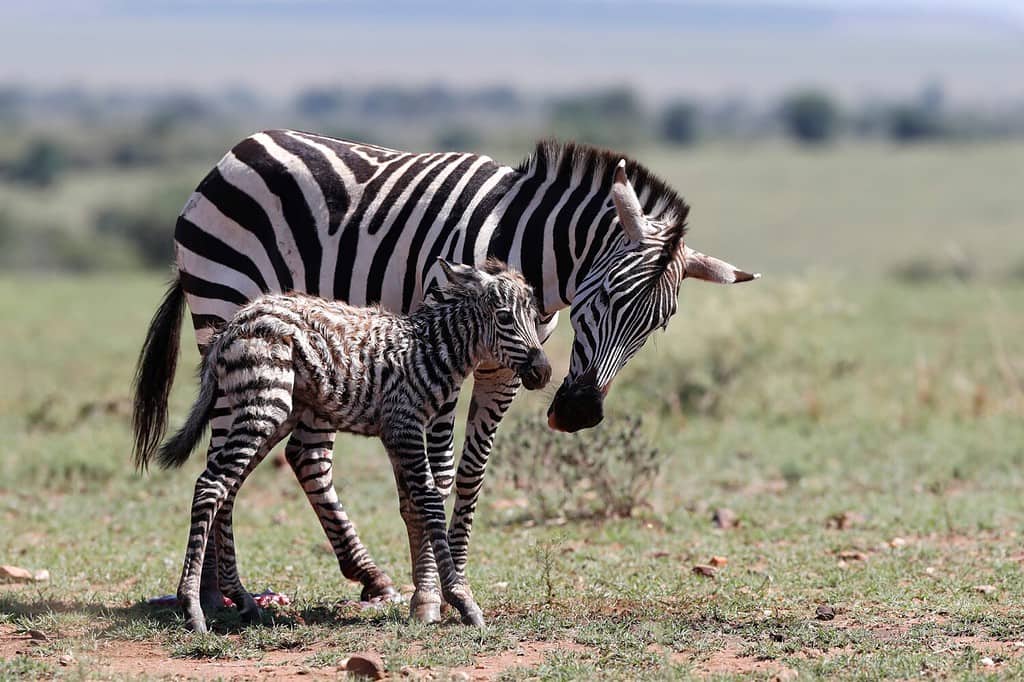
Baby zebras can stand within 15 minutes of birth and run by the time they are an hour old.
©godongphoto/Shutterstock.com
Perhaps one of the most famous striped animals, the zebra, has a fully black-and-white striped body and tail. These stripes help camouflage them in the grasslands and savannah of southern and eastern Africa. Each zebra’s stripes are unique, and no two have the same pattern — much like human fingerprints.
8. Large Indian Civet
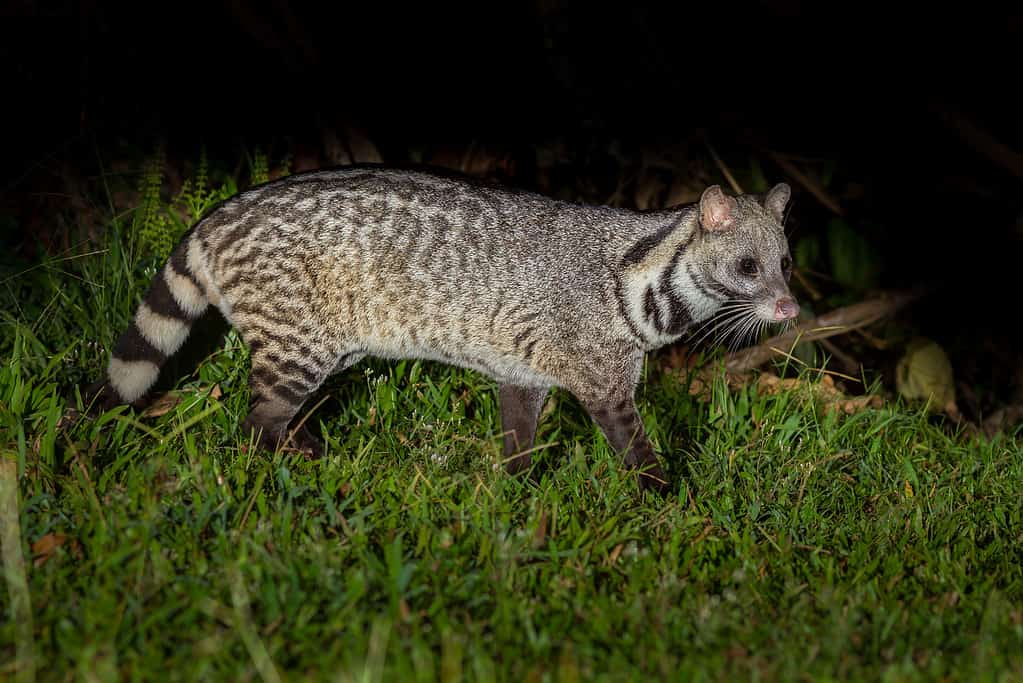
The large Indian civet is good at climbing but typically lives in holes dug by other animals.
©kajornyot/iStock via Getty Images
Nocturnal civet cats are found in forests across South and Southeast Asia, but you’ll be hard-pressed to see one. These elusive animals are solitary and nocturnal and are rarely seen during the day. Civets have large gray/brown bodies with black spots that camouflage well into the woods. Black-and-white stripes cross the underside of their necks, and their tails have thick black-and-white rings.
9. Cacomistle
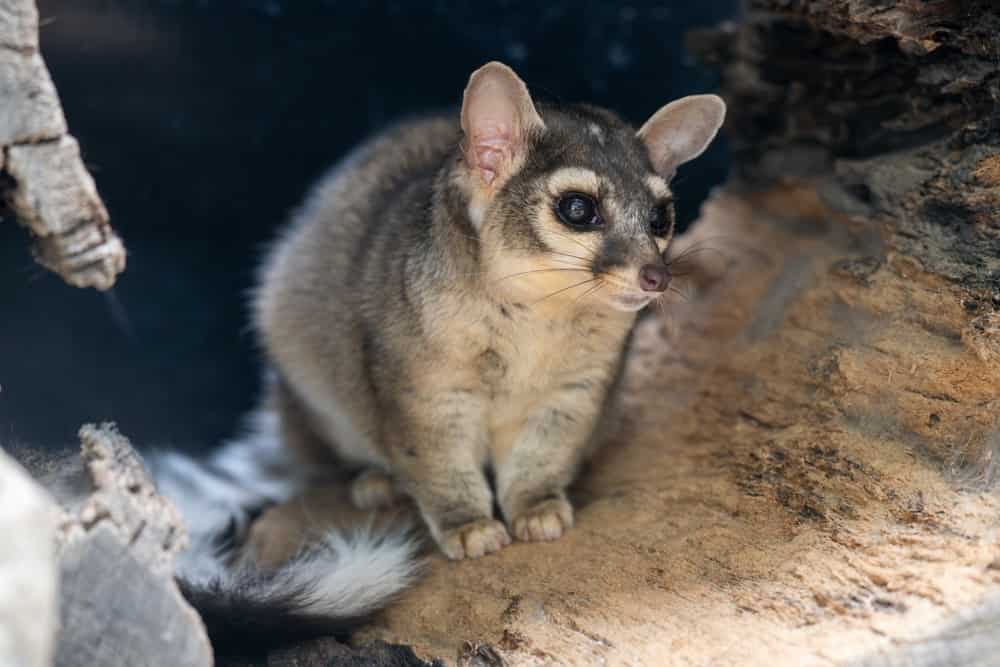
Cacomistles are nocturnal and primarily feed at night.
©Jason Mintzer/Shutterstock.com
The name cacomistle comes from the Nahuatl language in central Mexico. In English, it translates to “half mountain lion.” The tan front half of these small members of the Procyonidae family resembles a cat, while the tail is similar to that of a ring-tailed lemur with black and white stripes ringing the length.
10. Ring-Tailed Coati

Coatis are such good climbers that they mate and make nests in trees.
©LeoMercon/iStock via Getty Images
Ring-tailed coatis (also known as South American coatis) are a member of the raccoon family and have a similar brown-and-tan striped tail. Their bodies are grey and brown, with black legs and a long black snout. Coatis are excellent climbers and use their ringed tails for balance when they climb trees. When not climbing, they hold their tails high above their backs when they walk.
11. Bengal Tiger
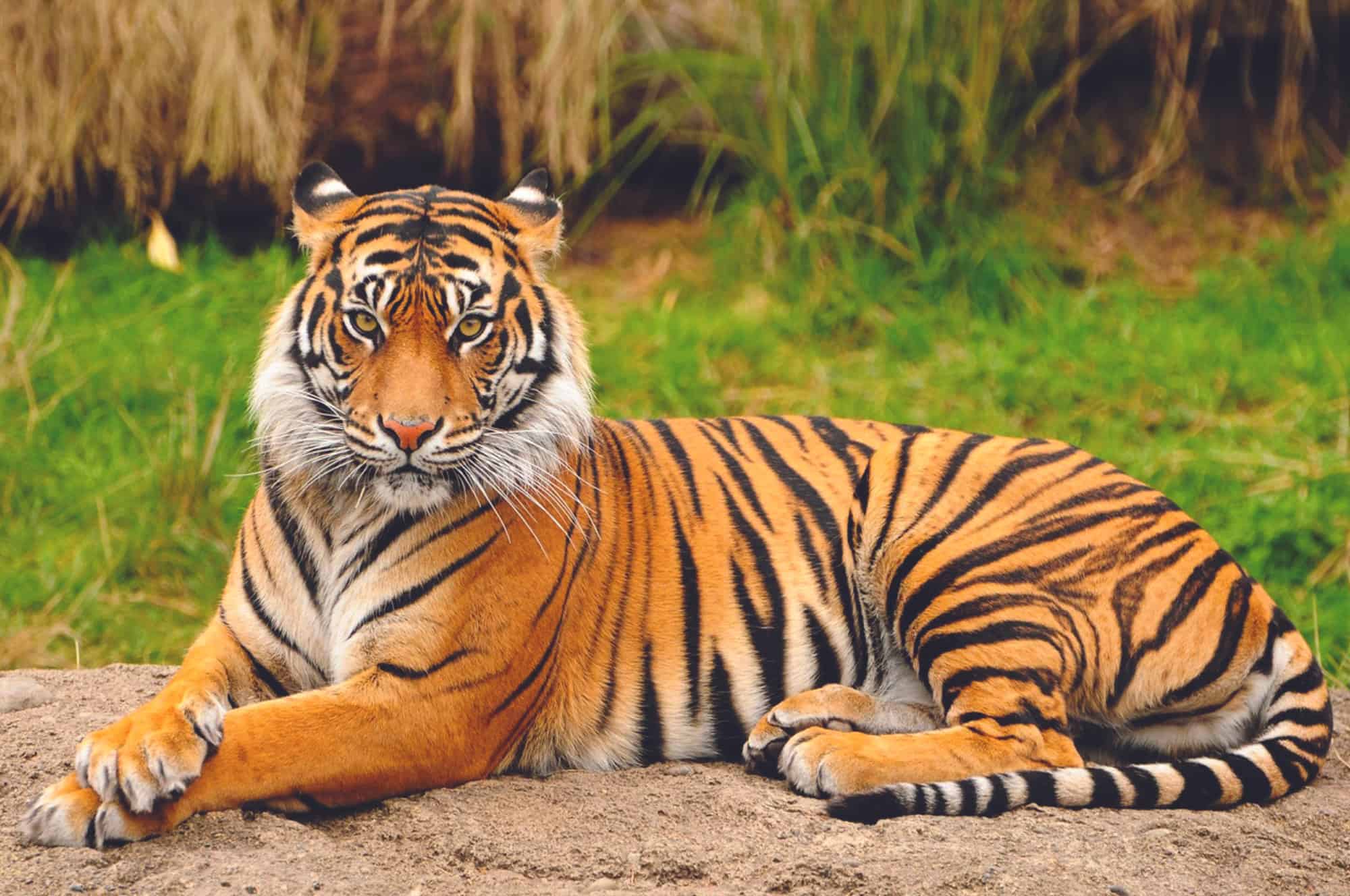
There are an estimated 2,500
Bengal tiger
s left in the wild.
©iStock.com/Thinker360
Tigers are another iconic striped species. Among the largest wild cats, these orange-and-black striped beauties weigh up to 500 pounds and are 10 feet long. This body length includes their tail, measuring up to 43 inches long. This long tail helps them balance when making quick directional changes when chasing prey.
12. Five-Lined Skink
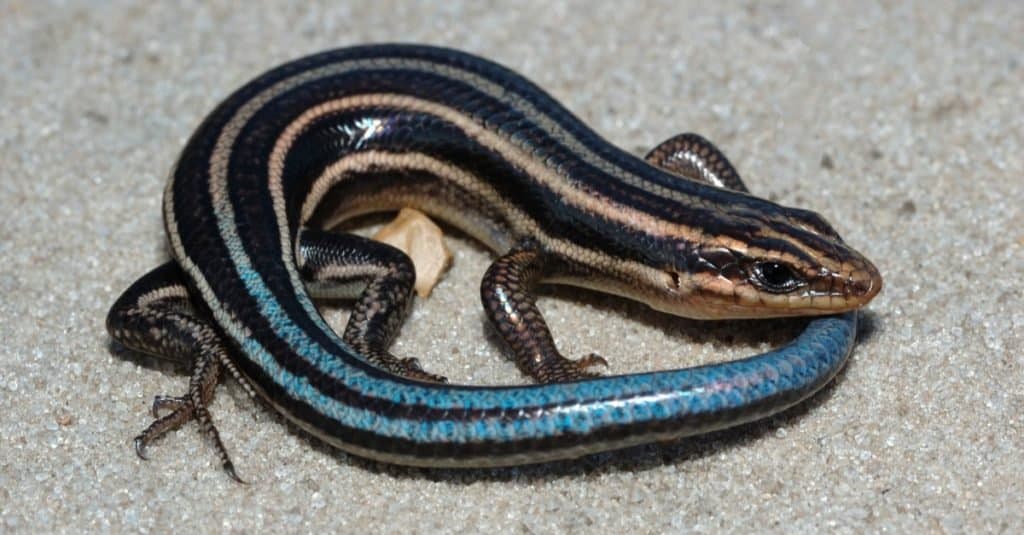
If caught by a predator, a skink can disconnect part or all of its tail to escape.
©James DeBoer/Shutterstock.com
One of 24 species of skink in North America, the five-lined skink has (you guessed it) five whitish lines running from its head down through its tail. Widely found across the eastern United States and southeastern Ontario, these skinks are nonvenomous and harmless to humans. Usually gray, brown, or black in base color, young skinks have blue tails that sometimes appear iridescent.
13. Red-Shouldered Hawk
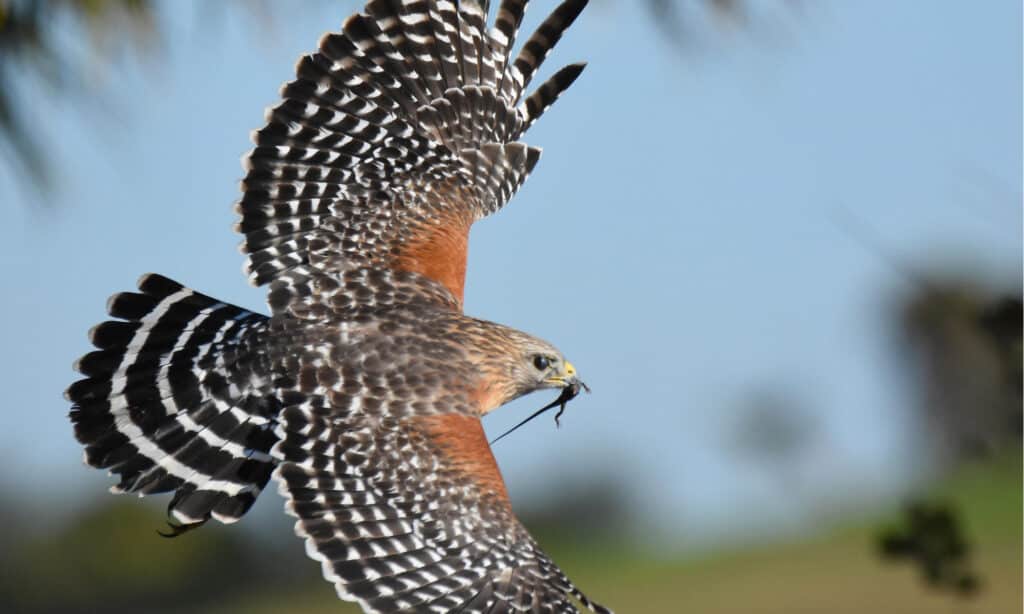
Female red-shouldered hawks are larger than males.
©MTKhaled mahmud/Shutterstock.com
Often mistaken for the red-tailed hawk, the red-shouldered hawk is a smaller bird with a rusty belly and white patterning. The hawk’s wings and tail have distinct alternating dark brown and white stripes. These beautiful birds return to the same nesting area every year, with one hawk reported to have returned to the same territory in California for 16 straight years.
14. Green Iguana
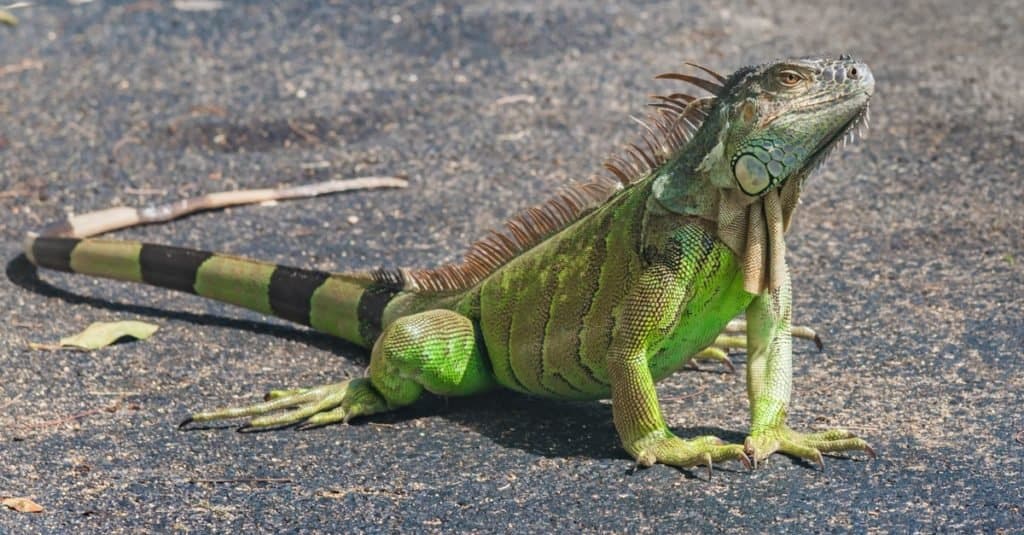
Iguanas are an invasive species in Florida and are not native to the region.
©David A Litman/Shutterstock.com
It’s hard to look at a green iguana and not think about dinosaurs! These massive lizards can grow to over five feet long, and males can weigh up to 17 pounds (with the largest iguana on record in Florida weighing 20 pounds). These adaptable iguanas live in various habitats, including suburban and urban areas across Florida, Central America, and northern South America. They range from bright green to brownish grey, with tails with distinct black rings.
15. Gila Monster

Gila monsters can eat up to a third of their body weight in one meal.
©Vaclav Sebek/Shutterstock.com
Another lizard that resembles a dinosaur is the Gila monster. This species of venomous lizard is native to the deserts of the southwestern United States. The only venomous lizard in the country, they have black and tannish-pink marbled bodies with striped tails. Despite being venomous, there have been no confirmed reports of human fatalities from Gila monster bites since 1930.
16. Ocelot

Ocelots are excellent climbers, swimmers, and runners, which helps them catch a large variety of prey.
©Saad315/Shutterstock.com
The ocelot is more commonly known for its spots, but its beautiful black-and-tan striped tail is striking. Found across South and Central America, there are around 60 ocelots confirmed to live in the United States in southeast Texas. Ocelots are similar in size to the bobcat, weighing 15-34 pounds.
17. Lady Amherst’s Pheasant
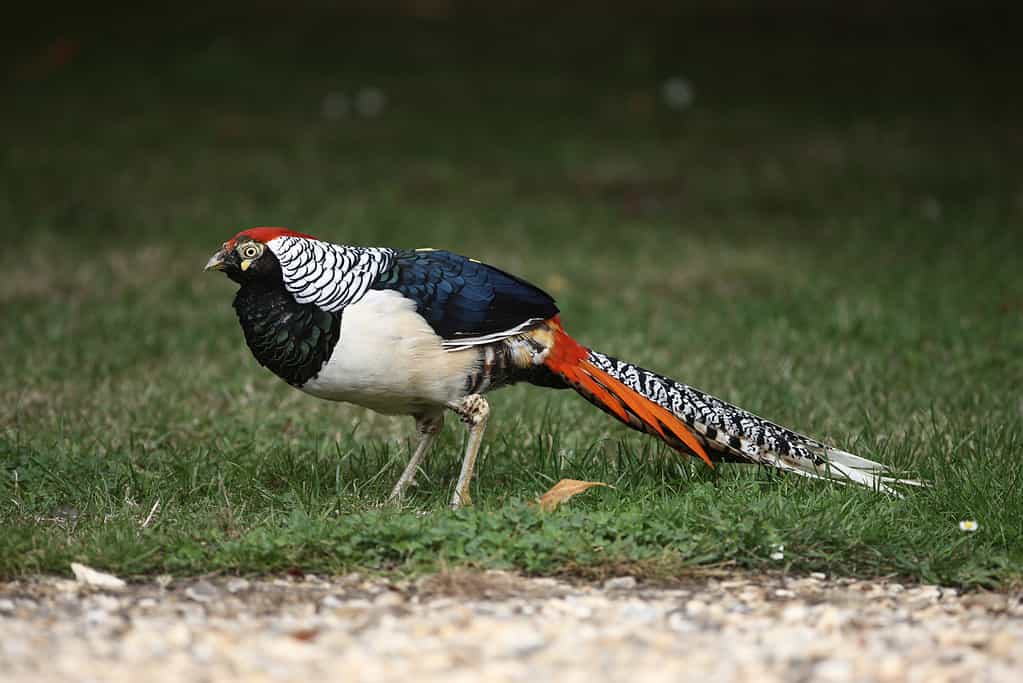
While Lady Amherst’s pheasants can fly, they usually prefer to run.
©MikeLane45/iStock via Getty Images
This colorful pheasant is named for Sarah Amherst, who, in 1828, was the first to bring a specimen of this exotic bird to England. Female pheasants are brown with mottled tan stripes and look similar to common and golden pheasants. However, males have dark green and white bodies with yellow rumps, remarkable long, black-and-white striped tails, and a dramatic red crest.
18. Zebra-Tailed Lizard
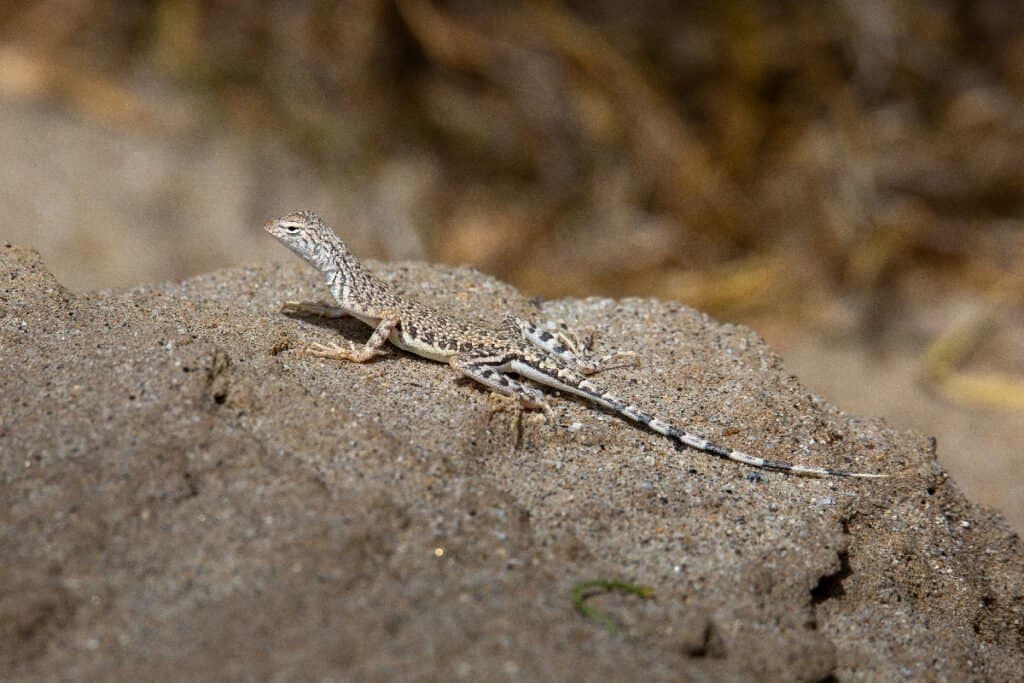
Zebra-tailed lizards can run over 23 feet per second.
©iStock.com/stevelenzphoto
Another North American reptile, the zebra-tailed lizard, is named for its black-and-white striped tail that resembles the pattern of a zebra. Primarily tannish gray with yellow, zebra-tailed lizards use dramatic physical motions such as head nods and push-ups to defend their territories from other lizards.
19. Cooper’s Hawk
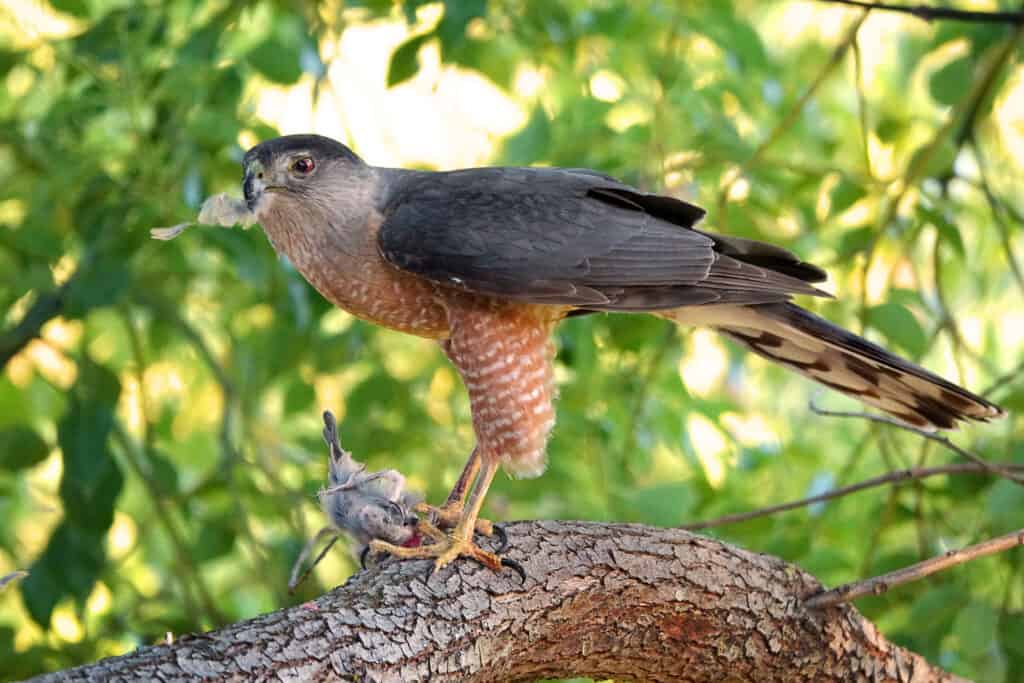
Cooper’s hawk
s can eat up to 12% of their body weight per day,
©iStock.com/Linda Koski
These hawks are part of a unique family of hawks called accipiters. These birds use their long tails to help them deftly maneuver midair for in-flight hunting. A medium-sized hawk, Cooper’s hawks have dark backs with broadly striped tails and white-and-red mottled chests.
20. Domestic Tabby Cat
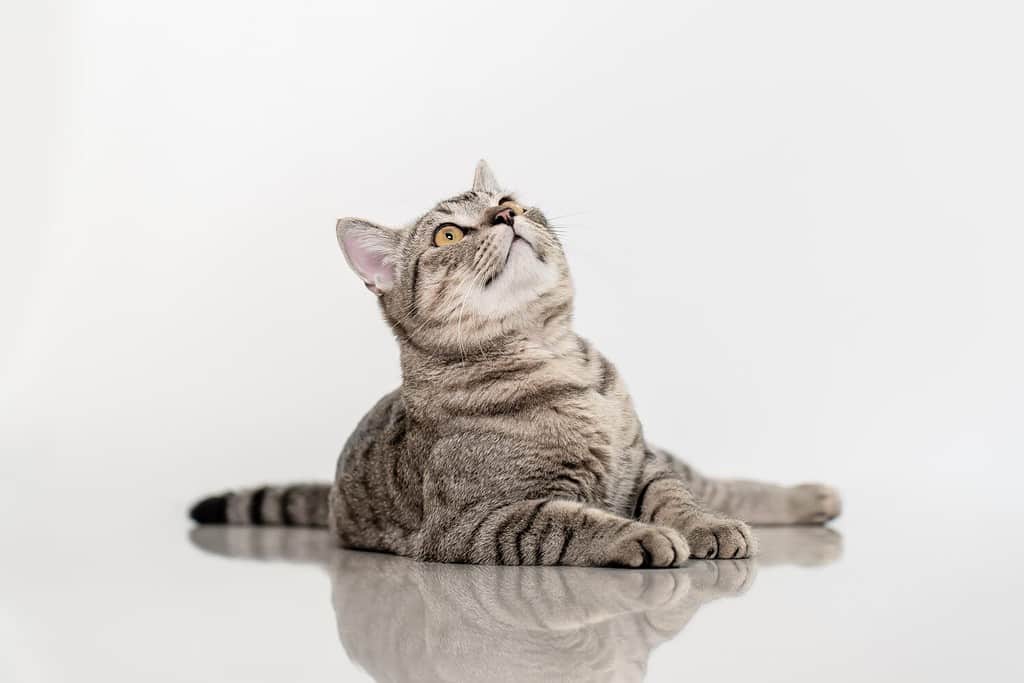
Tabby pattern types include striped, ticked, blotched, and mackerel.
©Nichcha/Shutterstock.com
Tabby cats are found in homes worldwide because who couldn’t resist those gorgeous stripes? Tabbies can have distinct stripes, spots, or swirling mixes of different colors in their coats, though most have striped rings around their tails and legs. “Tabby” is not a cat breed but rather a description of these cats’ unique coat markings — including a distinguishing “M” on their foreheads.
21. African Wild Dog

The
African wild dog
is endangered, with fewer than 6,000 remaining in the wild.
©iStock.com/Ondrej Prosicky
Also known as the painted dog or Cape Hunting dog, these round-eared canines are native to (as their name implies) sub-Saharan Africa. African wild dogs have gorgeous brindle coats, dark brown muzzles, and huge, rounded ears. Their puffy tails are tan at the base, with a black ring and a white tip. Wild dogs live in packs, usually averaging between seven and 15 dogs, but some packs have as many as 40 members.
22. Liger

Ligers can grow to 800-900 pounds, making them the largest cat in the world.
©AkulininaOlga/Shutterstock.com
Ligers are not a natural hybrid animal and don’t occur in the wild. These big cats result from humans breeding lions and tigers, two species that don’t share the same habitats and would never meet in the wild. The appearance of ligers varies based on their genetics, but most retain the stereotypical tiger stripes on their tails. They typically grow to be much bigger than either of their parent species.
23. Eastern Coral Snake
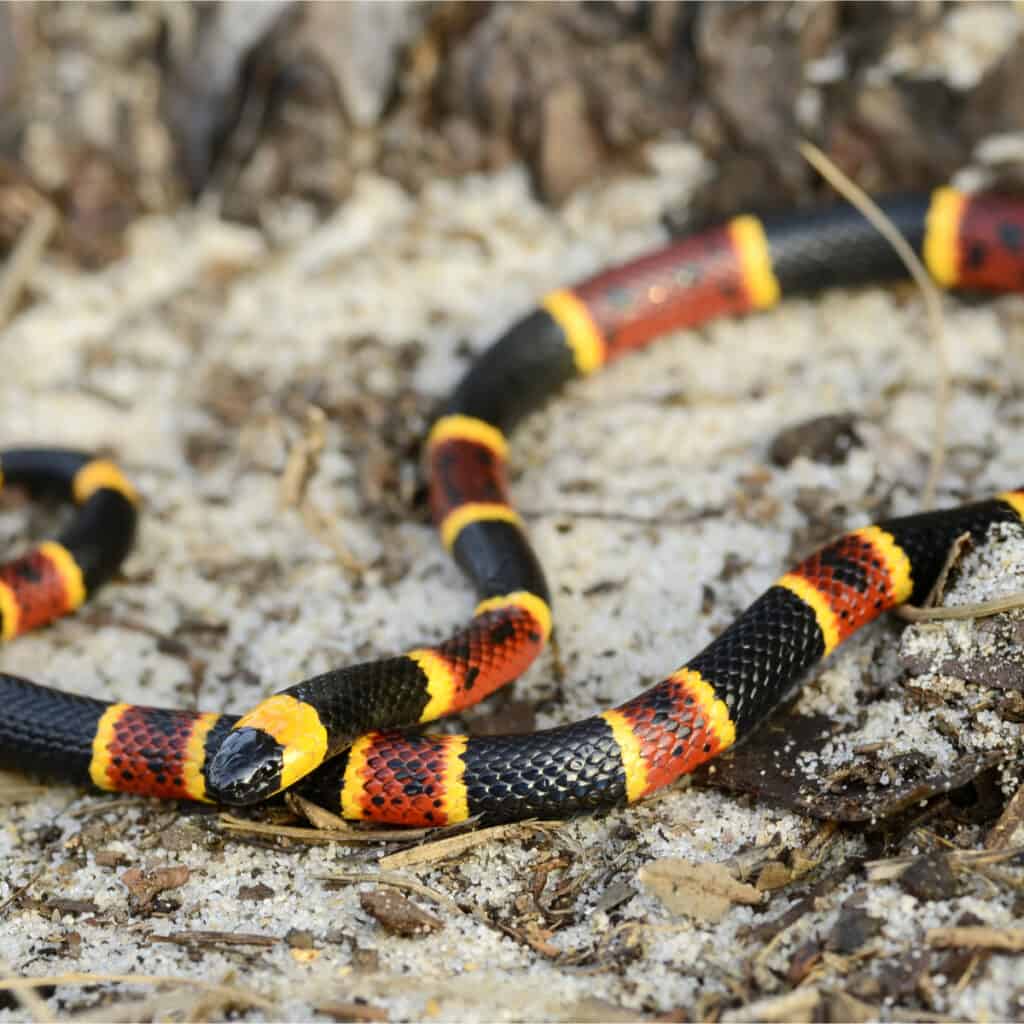
Coral snake venom affects the nervous system and causes muscle paralysis.
©Patrick K. Campbell/Shutterstock.com
Watch out — eastern coral snakes are highly venomous snakes! Endemic to the American southwest, these brightly colored snakes are entirely made up of stripes. From their head to the tips of their tails, the alternative black, yellow, and red stripes warn predators that these snakes mean business. Perhaps the most distinctly colored snake in the United States can easily be confused with the nonvenomous scarlet kingsnake, which has the same color stripes in a different order.
Summary of Animals with Striped Tails
| Animal Name | Scientific Name | |
|---|---|---|
| 1. | Raccoon | Procyon lotor |
| 2. | Striped skunk | Mephitis mephitis |
| 3. | Ring-tailed lemur | Lemur catta |
| 4. | Red panda | Ailurus fulgens |
| 5. | House gecko | Hemidactylus frenatus |
| 6. | Barred owl | Strix varia |
| 7. | Zebra | Equus quagga |
| 8. | Large Indian civet | Viverra zibetha |
| 9. | Cacomistle | Bassariscus sumichrasti |
| 10. | Ring-tailed coati | Nasua nasua |
| 11. | Bengal tiger | Panthera tigris tigris |
| 12. | Five-lined skink | Plestiodon fasciatus |
| 13. | Red-shouldered hawk | Buteo lineatus |
| 14. | Green iguana | Iguana iguana |
| 15. | Gila monster | Heloderma suspectum |
| 16. | Ocelot | Leopardus pardalis |
| 17. | Lady Amherst’s pheasant | Chrysolophus amherstiae |
| 18. | Zebra-tailed lizard | Callisaurus draconoides |
| 19. | Lady Amherst’s pheasant | Accipiter cooperii |
| 20. | Domestic tabby cat | Felis catus |
| 21. | African wild dog | Lycaon pictus |
| 22. | Liger | Panthera leo × Panthera tigris |
| 23. | Eastern coral snake | Micrurus fulvius |
The photo featured at the top of this post is © tratong/Shutterstock.com
Thank you for reading! Have some feedback for us? Contact the AZ Animals editorial team.







